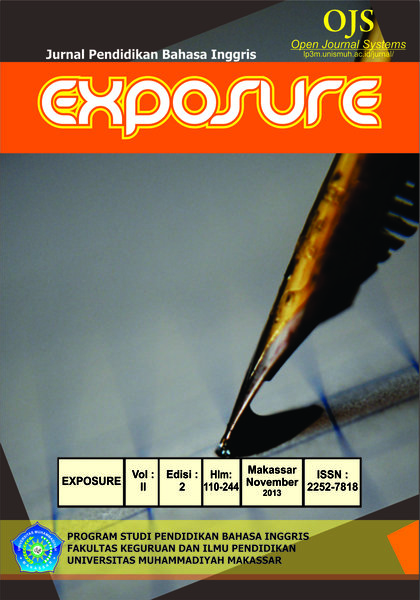IMPROVING THE STUDENTS’ ABILITY IN TRANSLATING ENGLISH INTO INDONESIAN BASED ON DUFF’S PRINCIPLES
DOI:
https://doi.org/10.26618/exposure.v2i2.791Abstract
This research aimed at finding out the improvement of the students’ ability in translating English into Indonesian especially for Recount text in terms of the meaning and style of the original text. The researcher used a Classroom Action Research (CAR) to explain the improvement, which was conducted in two cycles in which every cycle consisted of four meetings. The location of this research was taken in the second year of Junior High School 2 Sungguminasa with the number of the subject i.e. 36 students. The research findings indicate that the application of Duff’s Principles is significant in improving the students’ translating ability in terms of meaning and style of the original text. It is proved by the mean score of the cycle I is 60.27 then improved to be 72.49 in cycle II. They are higher than the mean score of diagnostic test namely 56.45. It means that there is the improvement of the students’ translating ability in terms of meaning and style of the original text.
Keyword: Ability, translating, English, Indonesian, Duff, principle
References
Brislin, W.R. 1976. Translation Application and Research. New York: Gardenes Press, Inc.
Broughton, G. 1980. Teaching English as a Foreign Language. Second Edition. London: Routledge and Paul.
Catford, J.C. 1965. A Linguistic Theory of Translation. London: Oxford University.
Choliludin. 2005. The Technique of Making Idiomatic Translation. Jakarta: Kesaint Blanc.
Direktorat Pendidikan Menengah Umum. 1999. Penelitian Pembelajaran Bahasa Inggris. Jakarta: Depdikbud.
Duff, A. 1989. Translation. London: Oxford University Press
Gay, L.R. 1981. Education Research: Competencies for Analysis and Application. Florida: Belland Howed.
Larson, M. 1984. Meaning-Based Translation USA University Press of America. Inc. Learner’s Packet Dictionary. London: Oxford University Press.
Longman. 2002. Language Activator. New Edition. Pearson Education Limited Printed in China.
Mertler, C.A. 2001. Designing Scoring Rubrics For Your Classroom. Practical Assessment, Research, and Evaluation. Retrieved September 15, 2012, from http://pareonline.net/getvn.asp?v=7&n=25.
Mettetal, G. 1997. Improving Teaching Trough Classroom Action Research. Indiana University South Bend.
Newmark, P. 1988. Approaches to Translation. New York: Pergamon Press.
Nida, E.A and Taber, Charles R. 1982. The Theory and Practice of Translation. Leiden, E.J Brill
Saranto, D.S. 2008. An Annotated Translation of The Mutiny on The Bounty. Journal of a thesis by Universitas Gunadarma.
Sudjana. 1999. Metode Stastika. Bandung : PT Gramedia.
Suling, L. 2007. An Annotated Translation of The President’s Mistress. Journal of a thesis by Universitas Gunadarma.
Tytler, A.F. 1790. Essay on The Principles of Translation.
Widyamartaya. 1993. Seni Menerjemahkan. Cet.III. Yogyakarta : Kanishing.
Downloads
Published
Issue
Section
License
Authors who publish with this journal agree to the following terms:
In order to assure the highest standards for published articles, a peer review policy is applied. In pursue of the compliance with academic standards, all parties involved in the publishing process (the authors, the editors and the editorial board and the reviewers) agree to meet the responsibilities stated below in accordance to the Journal publication ethics and malpractice statement.
Duties of Authors:
- The author(s) warrant that the submitted article is an original work, which has not been previously published, and that they have obtained an agreement from any co-author(s) prior to the manuscript’s submission;
- The author(s) should not submit articles describing essentially the same research to more than one journal;
- The authors(s) make certain that the manuscript meets the terms of the Manuscript Submission Guideline regarding appropriate academic citation and that no copyright infringement occurs;
- The authors(s) should inform the editors about any conflict of interests and report any errors they subsequently, discover in their manuscript.
Duties of Editors and the Editorial Board:
- The editors, together with the editorial board, are responsible for deciding upon the publication or rejection of the submitted manuscripts based only on their originality, significance, and relevance to the domains of the journal;
- The editors evaluate the manuscripts compliance with academic criteria, the domains of the journal and the guidelines;
- The editors must at all times respect the confidentiality of any information pertaining to the submitted manuscripts;
- The editors assign the review of each manuscript to two reviewers chosen according to their domains of expertise. The editors must take into account any conflict of interest reported by the authors and the reviewers.
- The editors must ensure that the comments and recommendations of the reviewers are sent to the author(s) in due time and that the manuscripts are returned to the editors, who take the final decision to publish them or not.
Authors are permitted and encouraged to post online a pre-publication manuscript (but not the Publisher’s final formatted PDF version of the Work) in institutional repositories or on their Websites prior to and during the submission process, as it can lead to productive exchanges, as well as earlier and greater citation of published work (see The Effect of Open Access). Any such posting made before acceptance and publication of the Work shall be updated upon publication to include a reference to the Publisher-assigned DOI (Digital Object Identifier) and a link to the online abstract for the final published Work in the Journal.

